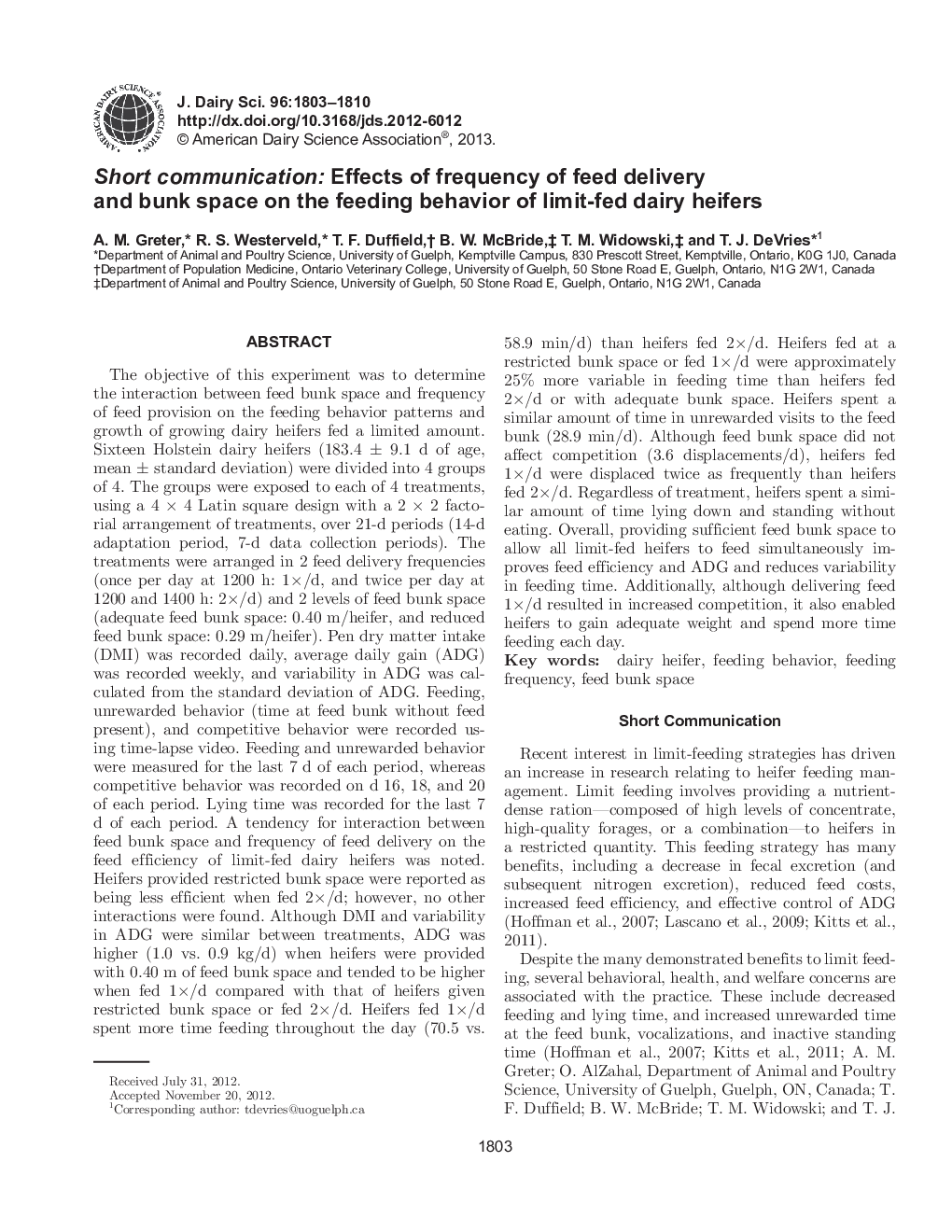| کد مقاله | کد نشریه | سال انتشار | مقاله انگلیسی | نسخه تمام متن |
|---|---|---|---|---|
| 10976223 | 1108039 | 2013 | 8 صفحه PDF | دانلود رایگان |
عنوان انگلیسی مقاله ISI
Short communication: Effects of frequency of feed delivery and bunk space on the feeding behavior of limit-fed dairy heifers
ترجمه فارسی عنوان
ارتباط کوتاه: تأثیر فرکانس تحویل خوراک و فضای خالی بر رفتار تغذیه تلیسه های شیری با محدودیت تغذیه
دانلود مقاله + سفارش ترجمه
دانلود مقاله ISI انگلیسی
رایگان برای ایرانیان
کلمات کلیدی
تلیسه لبنیات، رفتار تغذیه ای فرکانس تغذیه، فضای دوش خوراک
موضوعات مرتبط
علوم زیستی و بیوفناوری
علوم کشاورزی و بیولوژیک
علوم دامی و جانورشناسی
چکیده انگلیسی
The objective of this experiment was to determine the interaction between feed bunk space and frequency of feed provision on the feeding behavior patterns and growth of growing dairy heifers fed a limited amount. Sixteen Holstein dairy heifers (183.4 ± 9.1 d of age, mean ± standard deviation) were divided into 4 groups of 4. The groups were exposed to each of 4 treatments, using a 4 Ã 4 Latin square design with a 2 Ã 2 factorial arrangement of treatments, over 21-d periods (14-d adaptation period, 7-d data collection periods). The treatments were arranged in 2 feed delivery frequencies (once per day at 1200 h: 1Ã/d, and twice per day at 1200 and 1400 h: 2Ã/d) and 2 levels of feed bunk space (adequate feed bunk space: 0.40 m/heifer, and reduced feed bunk space: 0.29 m/heifer). Pen dry matter intake (DMI) was recorded daily, average daily gain (ADG) was recorded weekly, and variability in ADG was calculated from the standard deviation of ADG. Feeding, unrewarded behavior (time at feed bunk without feed present), and competitive behavior were recorded using time-lapse video. Feeding and unrewarded behavior were measured for the last 7 d of each period, whereas competitive behavior was recorded on d 16, 18, and 20 of each period. Lying time was recorded for the last 7 d of each period. A tendency for interaction between feed bunk space and frequency of feed delivery on the feed efficiency of limit-fed dairy heifers was noted. Heifers provided restricted bunk space were reported as being less efficient when fed 2Ã/d; however, no other interactions were found. Although DMI and variability in ADG were similar between treatments, ADG was higher (1.0 vs. 0.9 kg/d) when heifers were provided with 0.40 m of feed bunk space and tended to be higher when fed 1Ã/d compared with that of heifers given restricted bunk space or fed 2Ã/d. Heifers fed 1Ã/d spent more time feeding throughout the day (70.5 vs. 58.9 min/d) than heifers fed 2Ã/d. Heifers fed at a restricted bunk space or fed 1Ã/d were approximately 25% more variable in feeding time than heifers fed 2Ã/d or with adequate bunk space. Heifers spent a similar amount of time in unrewarded visits to the feed bunk (28.9 min/d). Although feed bunk space did not affect competition (3.6 displacements/d), heifers fed 1Ã/d were displaced twice as frequently than heifers fed 2Ã/d. Regardless of treatment, heifers spent a similar amount of time lying down and standing without eating. Overall, providing sufficient feed bunk space to allow all limit-fed heifers to feed simultaneously improves feed efficiency and ADG and reduces variability in feeding time. Additionally, although delivering feed 1Ã/d resulted in increased competition, it also enabled heifers to gain adequate weight and spend more time feeding each day.
ناشر
Database: Elsevier - ScienceDirect (ساینس دایرکت)
Journal: Journal of Dairy Science - Volume 96, Issue 3, March 2013, Pages 1803-1810
Journal: Journal of Dairy Science - Volume 96, Issue 3, March 2013, Pages 1803-1810
نویسندگان
A.M. Greter, R.S. Westerveld, T.F. Duffield, B.W. McBride, T.M. Widowski, T.J. DeVries,
